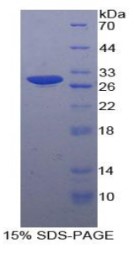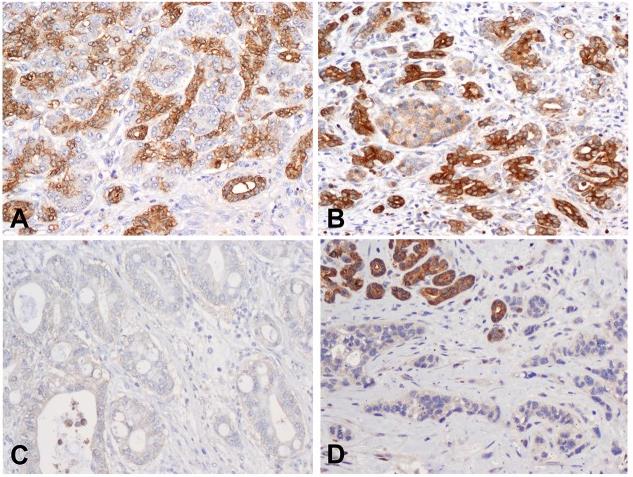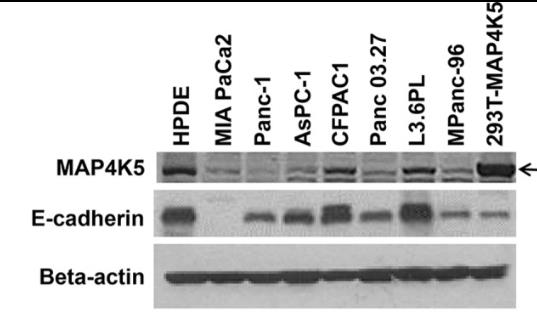MAP4K5
-
Official Full Name
mitogen-activated protein kinase kinase kinase kinase 5
-
Overview
This gene encodes a member of the serine/threonine protein kinase family, that is highly similar to yeast SPS1/STE20 kinase. Yeast SPS1/STE20 functions near the beginning of the MAP kinase signal cascades that is essential for yeast pheromone response. This kinase was shown to activate Jun kinase in mammalian cells, which suggested a role in stress response. Two alternatively spliced transcript variants encoding the same protein have been described for this gene. -
Synonyms
MAP4K5; mitogen-activated protein kinase kinase kinase kinase 5; GCKR; germinal center kinase related; KHS; KHS1; MEKKK 5; MEK kinase kinase 5; germinal center kinase-related; MAPK/ERK kinase kinase kinase 5; kinase homologous to SPS1/STE20; MAPKKKK5;
- Recombinant Proteins
- Cell & Tissue Lysates
- Protein Pre-coupled Magnetic Beads
- Human
- Human
- Mouse
- Zebrafish
- E.coli
- HEK293
- HEK293T
- Insect Cell
- Insect Cells
- Mammalian Cell
- Mammalian cells
- Sf21
- Sf9 Insect Cell
- Flag
- GST
- His
- His (Fc)
- Avi
- His|T7
- Myc
- DDK
- Myc|DDK
- N/A
- N
- Background
- Quality Guarantee
- Case Study
- Involved Pathway
- Protein Function
- Interacting Protein
- Other Resource
What is MAP4K5 protein?
Mitogen-activated protein kinase kinase kinase kinase 5 (MAP4K5), also known as germinal-center kinase-like protein kinase, is a novel human protein kinase that has been implicated in various cellular processes and diseases. MAP4K5 was first identified in the 1990s as part of the Mitogen-Activated Protein Kinase (MAPK) family, a group of serine/threonine kinases involved in intracellular signaling pathways that regulate a wide range of cellular activities. It's one of the relatively less studied members of the MAP kinases family, leading researchers to work meticulously to elucidate its functions.
The MAP4K5 gene is located on chromosome 6, specifically at locus 6q22.33. The gene encompasses approximately 84 kilobases and consists of 30 exons that translate into a protein composed of 934 amino acids.
The structure of MAP4K5 protein features an N-terminal kinase domain and various regulatory domains in the C-terminal, which has been suggested to regulate the catalytic activity of the kinase domain. Moreover, a characteristic feature of the MAP4K5 protein is the presence of a citron homology domain that might mediate protein-protein interactions.
What are the functions of MAP4K5 protein?
MAP4K5 is involved in various cellular processes, including cell proliferation, survival, differentiation, migration, and apoptosis. It serves as an upstream activating kinase in the JNK signaling pathway, a key regulator of cellular stress response. As an integral part of the MAPK family, it also interacts with other kinases to mediate signal transduction. It is worth noting that MAP4K5 can be activated by various stimuli, including growth factors, cytokines, and environmental stresses, highlighting its versatility in response to different cellular needs.
MAP4K5 Protein-Related Signal Pathways
Central to the function of MAP4K5 is its role in several signaling cascades. Predominantly, it functions in the c-Jun N-terminal kinase (JNK) signal transduction pathway. Activation of MAP4K5 results in the phosphorylation and activation of the JNK kinases, leading to the transcription of genes involved in cellular stress responses. Furthermore, it is also involved in the TGF-beta signaling pathway, playing a significant role in the regulation of cellular growth and development.
MAP4K5 Protein-Related Diseases
The dysregulation of MAP4K5 has been linked to a number of diseases. For example, increased expression of MAP4K5 has been detected in human gliomas, the most common type of primary brain tumor. This increased expression is associated with tumor progression and poor patient prognosis. Moreover, the overexpression of MAP4K5 also has been implicated in acute myeloid leukemia, while its reduced expression has been reported in neurodegenerative diseases such as Parkinson's. Clearly, understanding the role of MAP4K5 in different disease states may open up new therapeutic avenues.
- Cancer: Low MAP4K5 expression is seen in several cancers like hepatocellular carcinoma, gastric cancer, and colorectal cancer. It may function as a tumor suppressor.
- Obesity and diabetes: Variants in MAP4K5 have been associated with increased risk of obesity, type 2 diabetes and related traits like higher BMI and waist circumference.
- Cardiovascular disease: Genetic polymorphisms in MAP4K5 are linked to increased risk of coronary artery disease and myocardial infarction.
- Neurodegenerative diseases: MAP4K5 mutations may contribute to motor neuron degeneration seen in amyotrophic lateral sclerosis (ALS).
- Cancer therapy: MAP4K5 acts as a tumor suppressor in several cancers. Understanding its signaling pathway could help develop drugs/gene therapies to restore its activity and induce cancer cell apoptosis.
- Neurodegeneration: Elucidating MAP4K5's role in diseases like Alzheimer's and ALS may reveal novel therapeutic targets related to amyloid processing, neuroinflammation, neuronal survival pathways.
- Obesity/diabetes treatment: Compounds modulating MAP4K5 signaling could help control metabolic dysregulation, inflammation contributing to these conditions.
Considering the ability of MAP4K5 to influence many key cellular processes, the potential applications of this protein in the medical field cannot be understated. For example, drugs that inhibit MAP4K5 might slow the progression of gliomas and leukemia. Conversely, agents that boost MAP4K5 activity could potentially contribute to therapies for neurodegenerative diseases.
Furthermore, given its role in cellular response to environmental stressors, MAP4K5 could be a noteworthy research target for the development of interventions aimed at promoting cellular resilience and longevity. Also, its involvement in growth and development suggests potential applicability in tissue engineering and regenerative medicine.
- Cancer therapy: MAP4K5 acts as a tumor suppressor in several cancers. Understanding its signaling pathway could help develop drugs/gene therapies to restore its activity and induce cancer cell apoptosis.
- Neurodegeneration: Elucidating MAP4K5's role in diseases like Alzheimer's and ALS may reveal novel therapeutic targets related to amyloid processing, neuroinflammation, neuronal survival pathways.
- Obesity/diabetes treatment: Compounds modulating MAP4K5 signaling could help control metabolic dysregulation, inflammation contributing to these conditions.
High Purity

Fig1. SDS-PAGE (Cat. No.: MAP4K5-1536H)
Case 1:Wang OH,et al. Prognostic and Functional Significance of MAP4K5 in Pancreatic Cancer. PLoS One. 2016 Mar 29;11(3):e0152300. doi: 10.1371/journal.pone.0152300. PMID: 27023625; PMCID: PMC4811546.
MAP4K5 plays an important role in regulating a range of cellular responses and is involved in Wnt signaling in hematopoietic cells. However, its functions in human malignancies have not been studied. The major objectives of this study are to examine the expression, functions and clinical significance of MAP4K5 in pancreatic ductal adenocarcinoma (PDAC).
MAP4K5 expression is decreased or lost in majority of PDACs. The strong associations between low MAP4K5 expression and loss of E-cadherin, reduced CES2 expression and decreased overall survival may suggest an important role of MAP4K5 in epithelial-to-mesenchymal transition, chemotherapy resistance and tumor progression in pancreatic cancer. Targeting impaired MAP4K5 signaling may represent a new therapeutic strategy for pancreatic cancer.

Fig1. Expression of MAP4K5 in non-neoplastic pancreas and pancreatic ductal adenocarcinoma samples. Representative micrographs show the expression of MAP4K5 in normal pancreatic tissue (A) and chronic pancreatitis (B). The benign pancreatic ductal cells in normal pancreas and chronic pancreatitis show strong cytoplasmic staining for MAP4K5. The adjacent pancreatic acinar cells and pancreatic islet cells are either negative or have very low expression of MAP4K5. C & D, Representative micrographs show the loss of MAP4K5 expression in two different pancreatic ductal adenocarcinoma samples. Strong cytoplasmic staining for MAP4K5 in benign pancreatic ductal cells in the left upper corner in D served as internal positive control. Original magnifications: 200X.
Case 2: Yu R, et al. ARG2, MAP4K5 and TSTA3 as Diagnostic Markers of Steroid-Induced Osteonecrosis of the Femoral Head and Their Correlation With Immune Infiltration. Front Genet. 2021 Jul 26;12:691465. doi: 10.3389/fgene.2021.691465. PMID: 34381494; PMCID: PMC8350574.
Researchers identified 383 DEGs overall. This study found ARG2, MAP4K5, and TSTA3 (AUC = 0.980) to be diagnostic markers of SONFH. The results of qRT-PCR showed a statistically significant difference in all markers. Analysis of infiltration of immune cells indicated that neutrophils, activated dendritic cells and memory B cells were likely to show the relationship with SONFH occurrence and progress.

Fig2. Immunoblotting for MAP4K5 and E-cadherin expression in HPDE cells, immortalized human pancreatic ductal cells, and pancreatic cancer cell lines. The 293T cells transfected with MAP4K5 cDNA construct saved as a positive control for immunoblotting.

Fig1. Validation of the expressions of potential diagnostic markers via qRT-PCR.
MAP4K5 involved in several pathways and played different roles in them. We selected most pathways MAP4K5 participated on our site, such as Insulin Signaling, TNF receptor signaling pathway, which may be useful for your reference. Also, other proteins which involved in the same pathway with MAP4K5 were listed below. Creative BioMart supplied nearly all the proteins listed, you can search them on our site.
| Pathway Name | Pathway Related Protein |
|---|---|
| Insulin Signaling | INPP4AA;STXBP3A;GRB14;STXBP4;MYO1C;ARHGAP33;MAP3K2;RHOJ;MAP3K9 |
| TNF receptor signaling pathway | TNIK;NRK;RFFL;MAP4K5 |
MAP4K5 has several biochemical functions, for example, ATP binding, MAP kinase kinase kinase kinase activity, protein binding. Some of the functions are cooperated with other proteins, some of the functions could acted by MAP4K5 itself. We selected most functions MAP4K5 had, and list some proteins which have the same functions with MAP4K5. You can find most of the proteins on our site.
| Function | Related Protein |
|---|---|
| ATP binding | RARS;ACLYA;MAST2;CAD;DDX3X;EPHA7;RPS6KA1;RHOBTB3;PIK3R4 |
| MAP kinase kinase kinase kinase activity | MAP4K1;MAP4K3;ALPK2;MAP4K6;MAP4K5;MAP4K2 |
| protein binding | CCDC103;PDE4D;Cd79a, Cd79b;UBE2D3;CCNDBP1;FCHSD2;FZR1;KPNA6;TNNI3 |
| protein kinase activity | GSG2;CAMK2B1;DCLK1;GC3;SLKA;MAP2K2B;INSRB;MAP4K1;STK25B |
| protein serine/threonine kinase activity | PKN1B;STK3;DMPK;CSNK1D;PLK1;ERN1;IKBKB;MAPK8A;CHEK1 |
MAP4K5 has direct interactions with proteins and molecules. Those interactions were detected by several methods such as yeast two hybrid, co-IP, pull-down and so on. We selected proteins and molecules interacted with MAP4K5 here. Most of them are supplied by our site. Hope this information will be useful for your research of MAP4K5.
GRB2; CRK; abl-tide; FYN; NCK1; CRKL; HCK; SETDB1; ZNF440; COPS5; linkable pd173955 analogue; bosutinib
Research Area
Related articles
- Q&As
- Reviews
Q&As (5)
Ask a questionAs of now, MAP4K5-targeted therapies are primarily in the experimental stage, and none have been approved for clinical use.
MAP4K5 is involved in modulating immune responses, and its dysregulation may contribute to autoimmune disorders.
MAP4K5 has been implicated in neurodegenerative disorders, and its study may provide insights into the underlying mechanisms of these conditions.
There is evidence suggesting that MAP4K5 may contribute to drug resistance in certain cancer types, making it an important target for overcoming resistance mechanisms.
Personalized medicine approaches are being explored to tailor MAP4K5-targeted therapies based on individual patient characteristics and disease profiles.
Customer Reviews (3)
Write a reviewIts reliability and applicability make it an invaluable tool for investigating MAP4K5 protein's expression, function, and structural characteristics.
Manufacturers can enhance the research process by providing high-quality MAP4K5 protein, technical support, customization options, and potentially collaborative opportunities.
The high-quality MAP4K5 protein available from manufacturers ensures consistent and reproducible results in WB experiments, making it an essential tool for researchers studying ANO2-related pathways and biological processes.
Ask a Question for All MAP4K5 Products
Required fields are marked with *
My Review for All MAP4K5 Products
Required fields are marked with *


